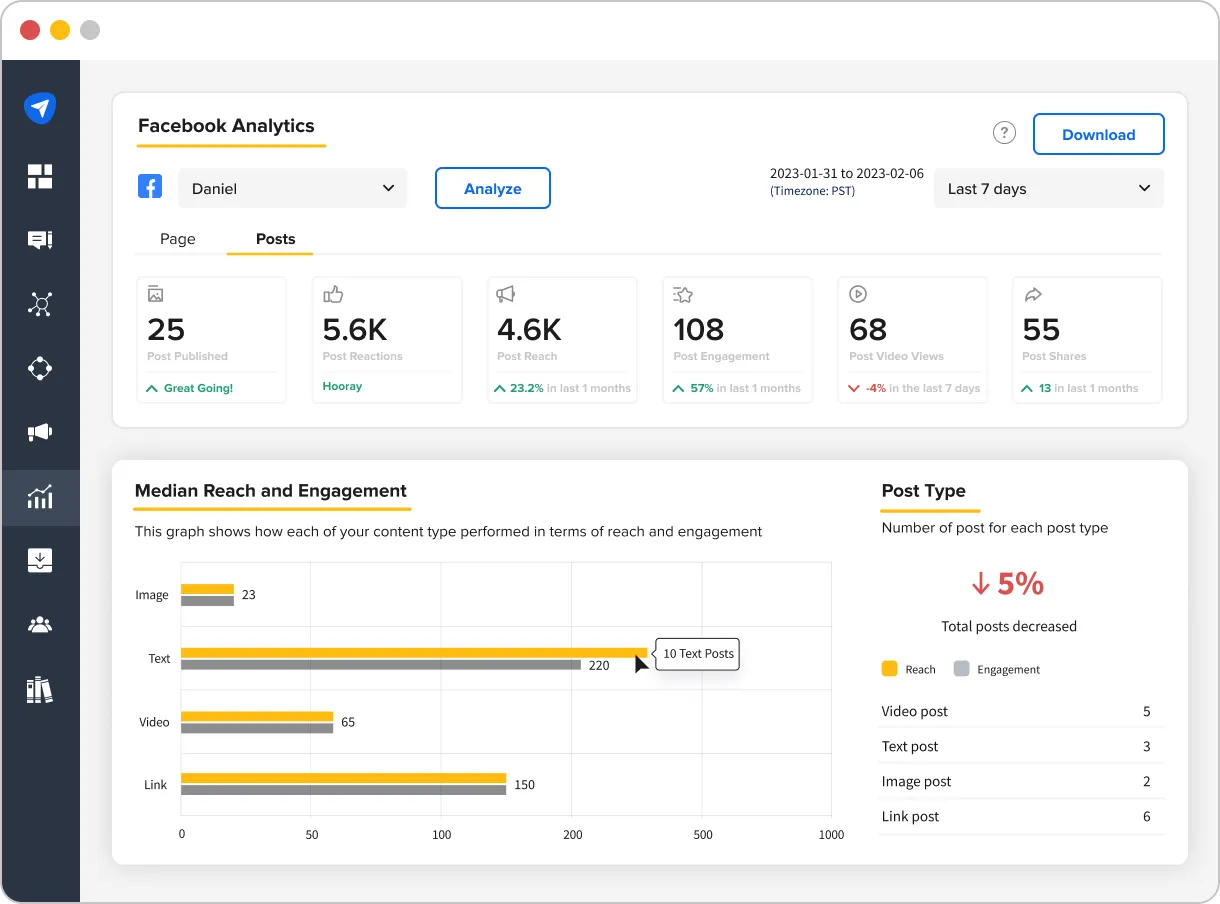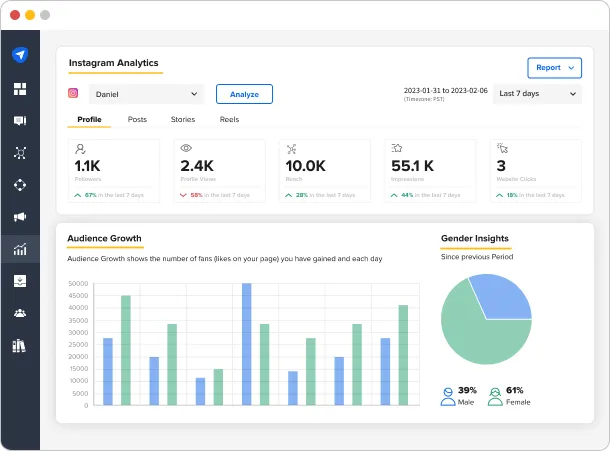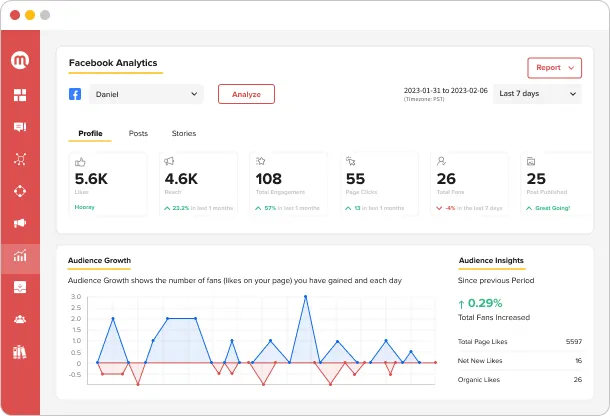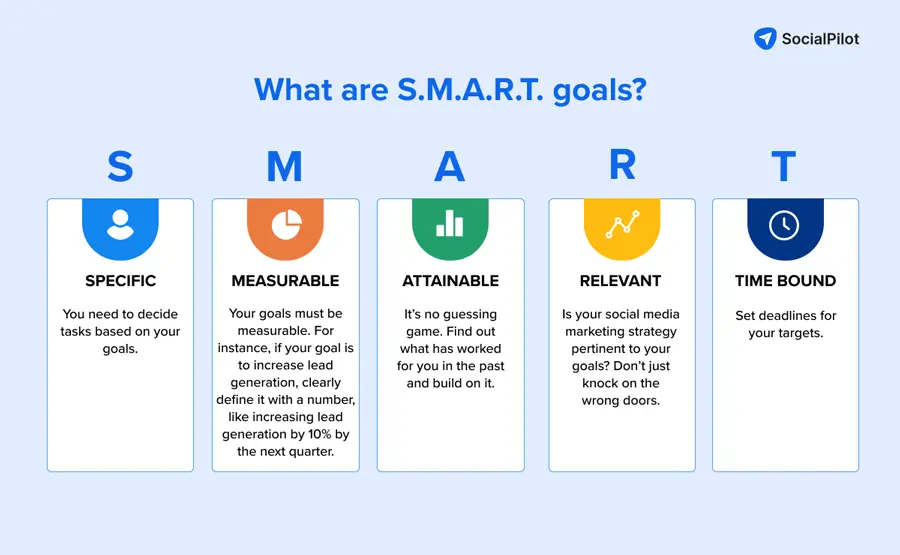Struggling to make sense of your social media performance? That’s where a social media analytics dashboard comes in. It’s your one-stop solution to track, measure, and optimize campaigns across platforms like Instagram, Facebook, X, and LinkedIn—all in real-time.
By giving you a clear picture of what’s working and what’s not, these dashboards help you cut through the noise and focus on strategies and campaigns that deliver results. Whether you’re a small business looking to improve ROI or an agency managing multiple clients, an analytics dashboard simplifies reporting and decision-making.
Ready to transform raw data into actionable insights? Let’s jump straight into everything you need to know about choosing the right social media analytics dashboard for your needs.
But first…..
A social media analytics dashboard is a centralized tool that consolidates all the key social media performance metrics across all platforms, allowing users to track, measure, and analyze the effectiveness of their social media campaigns in real time. It gives you a snapshot of your posts’ performance, audience engagement, and even follower growth. Think of it as a real-time report card for your social media strategy.
With this dashboard, you can track key metrics such as post likes, comments, shares, and followers. But the real magic happens when it goes beyond the surface. A good dashboard breaks down deeper into audience demographics, engagement rates, best-performing content, growth trends, and competitor benchmarking.
In short, instead of diving into endless Excel sheets or multiple platforms, the dashboard presents everything in a quick glance in an easy-to-understand format with charts and graphs.
The best part? You get real-time insights, allowing you to make data-driven decisions. In a nutshell, if you’re serious about growing your social media, having an analytics dashboard isn’t just a nice-to-have; it’s a game-changer.
Let’s explore different types of dashboards and what they bring to the table:
We have highlighted four key dashboards that cater to different aspects of social media performance, ensuring you always have the right insights to optimize your strategy.
Imagine you just launched a new product and want to run a campaign on Instagram, Facebook, X/Twitter and more. How will you measure the campaign’s performance? By opening analytics of every platform? Too, tedious. The answer is a comprehensive social media engagement dashboard.
With the engagement dashboard, you can track which posts get the most comments, which are being shared, and how your audience interacts overall. This insight helps you adjust your strategy in real time to maximize engagement.
Why you need it:
You can understand which type of content resonates with your target audience, identify trends, and optimize your posting strategies.
Key metrics: Likes, comments, shares, post engagement rates, page engagement rate, total posts, Instagram Story replies, forwards, exits, and top-performing content.
Supported social media platforms: Facebook, Instagram, X/Twitter, YouTube, LinkedIn, and Google Business Profile
For instance, we have showcased an example of SocialPilot’s engagement dashboard. It eliminates the hassle of tracking your post performance by offering a comprehensive engagement dashboard, enabling you to measure your social performance holistically. This tool simplifies engagement tracking by collecting data from all major media platforms into a user-friendly interface. Here are some of its key features:
- Platform-Wide Analytics: Track engagement metrics for Facebook, Instagram, X, YouTube, LinkedIn, and Google Business Profile all in one place.
- Engagement Trends: Get detailed insights into spikes and dips in engagement over time, helping you identify patterns.
- Post-Level Analysis: Understand which specific posts performed best, down to the smallest detail.


Note: If you are stuck with low social media engagement, here is a webinar from the elite you should listen to.
The Social Media Audience Growth Dashboard is all about tracking how well your audience, a.k.a followers, are growing. This dashboard helps you see how well your marketing efforts are paying off and whether you’re attracting the right audience.
Let’s say your business recently started creating Instagram Reels or YouTube content. The audience growth dashboard shows you not only how many followers you’ve gained but also their demographics (age, gender, and location).
Why you need it:
Continuously tracking your audience insights ensures your follower growth aligns with your target demographics. This dashboard gives you a look into audience trends for a specific marketing campaign across multiple platforms.
Key metrics: Follower growth, age, gender, location, peak times, peak days, and most active likers, commenters, and sharers.
Supported social media platforms: Facebook, Instagram, X/Twitter, YouTube, LinkedIn, and Google Business Profile
If you want to access audience insights all in one place, the SocialPilot audience growth dashboard gives you a detailed look into your demographics. You can check insights such as follower growth, age, gender, and location, helping you craft more targeted content. Want more? You can track trends over weeks or months, ensuring your strategy is always up-to-date with your trends.


If you are into posting branded Reels, Shorts, or TikTok and want to know how much impact these are creating, the social media awareness dashboard is for you.
This dashboard makes it convenient for you and your team to measure your brand awareness and how your campaigns are performing and driving share of voice. You can use this to monitor branded hashtags and mentions and identify platforms that drive the most visibility for your brand.
Why You Need It:
Understand how much of your target audience is aware of your brand. How they interact with your brand across all social platforms.
Key Metrics: Impressions, reach, Share of voice, Branded hashtags, and Traffic to your website from social media.
Supported social media platforms: Facebook, Instagram, X/Twitter, YouTube, LinkedIn, and Google Business Profile.
The Awareness Dashboard simplifies the process of tracking visibility metrics. Here’s what you get:
- Cross-Platform Reach Tracking: Monitor impressions and reach across all platforms in one place.
- Hashtag Performance Insights: See which branded hashtags are driving the most visibility.
- Competitor Comparisons: Benchmark your brand’s visibility against industry leaders.
- Traffic Attribution: Understand how much traffic each platform is driving to your website.
The Social Media Reporting Dashboard is designed for marketers and agencies who need to compile performance data into professional reports. It’s perfect for presenting results to clients or stakeholders, showcasing the value of your efforts with clarity and precision.
Why You Need It:
Presenting data effectively is just as important as gathering it. With this dashboard, you can:
- Save hours by automating reporting tasks.
- Showcase ROI for specific campaigns.
- Provide stakeholders with clear, actionable insights.
Key Metrics:
- Campaign performance summaries
- ROI tracking (e.g., cost per click, cost per acquisition)
- Multi-platform performance comparison
- Custom metrics by date range
Supported social media platforms: Facebook, Instagram, X/Twitter, YouTube, LinkedIn, and Google Business Profile
Take a look at the example of SocialPilot’s reporting dashboard. It is tailored for teams and agencies that need polished, customizable reports. Here’s why it stands out:
- Customizable Report Templates: Build reports that focus on the metrics your clients or stakeholders care about most.
- White-Label Reporting: Add your own branding to give reports a professional touch.
- Comprehensive Data Consolidation: Pull data from all connected platforms into a single report.
- Visual Reporting Tools: Use charts and graphs to make data more digestible.
The ability to automate and customize reports ensures that your presentations are both professional and impactful, saving you time and effort.


Need information on what types of analytics dashboards are available based on the social platforms? Lets break down each:
Ever feel like you’re posting into the void? A Facebook analytics dashboard is your ultimate ally in understanding what truly works.
Key Metrics to watch:
- Reach: Want to know how many people actually saw your posts? This metric reveals your content’s exposure.
- Engagement: Likes, comments, shares, and clicks—these show how actively your audience interacts with your posts.
- Demographics: Curious about who’s engaging with your content? This tells you the age, gender, and location of your followers.
- Page Insights: Monitor page likes, unlikes, and overall growth trends.
Why It matters:
With billions of active users, Facebook is a crowded space. By analyzing these metrics, you can tailor your content to meet your audience where they are and maximize engagement.
Struggling to crack the code for more likes and follows? Instagram analytics hold the key.
Key Metrics to watch:
- Post and Story Analytics: Which posts are drawing double taps and comments? Which Stories keep viewers engaged till the end?
- Hashtag Performance: Wondering if your hashtags are working? Track their reach and impact.
- Follower Growth: See who’s joining (or leaving) your tribe—and why.
- Reels Analytics: Identify which short-form videos are driving the most engagement.
Pro Tip:Instagram’s algorithm prioritizes engagement, so use these metrics to craft content that keeps users interacting with your posts.
X (Twitter)
Think a tweet is just 280 characters? Think again.
Key Metrics to watch:
- Impressions: How far did your tweet fly? This tells you how many users saw it.
- Engagement Rate: Are your tweets inspiring clicks, replies, retweets, or likes?
- Audience Insights: Want to post when your followers are most active? This data guides your timing strategy.
- Hashtag Tracking: Which hashtags drive the most traffic to your profile?
Why It matters:
With Twitter’s fast-paced nature, real-time analytics are essential to capitalize on trends and make your tweets go viral.
YouTube
Think you’re just entertaining your audience? You might be missing the bigger picture.
Key Metrics to Watch:
- Watch Time: Are viewers sticking with your videos or dropping off early?
- CTR (Click-Through Rate): Are your thumbnails and titles compelling enough to drive clicks?
- Subscriber Growth: See who’s joining your community and what content is converting them.
- Traffic Sources: Discover where your views are coming from—search, suggested videos, or external links.
Why It Matters:
YouTube’s algorithm rewards engagement and retention. By understanding these metrics, you can create content that captivates your audience and boosts your channel’s visibility.
Google Business Profile
Think local SEO doesn’t need analytics? Think again.
Key Metrics to Watch:
- Search Views: How often does your business appear in search results?
- Customer Actions: See how many users call, click, or request directions.
- Photo Views: Are your images attracting attention?
- Review Monitoring: Stay on top of customer feedback to build trust.
Why It Matters:
Google Business Profile analytics are essential for local businesses to optimize visibility and attract more customers to their doors.
LinkedIn–the woolly mammoth of the B2B space.
Key Metrics to Watch:
- Post Engagement: Which articles, updates, or videos are driving comments and shares?
- Profile Views: Track who’s visiting your profile and their roles.
- Follower Demographics: Understand the industries, seniority levels, and locations of your followers.
- Click-Through Rates: See how well your call-to-actions (CTAs) resonate.
Pro Tip: LinkedIn is all about professional branding. Use these metrics to establish thought leadership and nurture valuable business relationships.
Wondering how to use these insights across platforms?
By using a comprehensive social media analytics dashboard, you can track these metrics in one place, compare performance across platforms, and make data-driven decisions.
Need recommendations on how to get started with creating a custom dashboard? Here’s how you create one:
Creating a social media dashboard might seem daunting, but it doesn’t have to be. Here’s a step-by-step guide to help you set up a dashboard that delivers actionable insights tailored to your needs.
Step 1: Define Your Objectives
Before you dive into metrics, ask yourself: What do I want to achieve with my social media efforts?
Start by conducting a SWOT analysis for your social media strategy.
- Strengths: What’s working well?
- Weaknesses: Where are you falling short?
- Opportunities: What trends or untapped audiences can you leverage?
- Threats: What challenges or competitors are you up against?
For a detailed walkthrough, check out Social Media SWOT Analysis.
Next, set SMART goals—goals that are Specific, Measurable, Achievable, Relevant, and Time-bound.


For instance:
- Specific: “Increase Instagram followers by 20% in Q1.”
- Measurable: Use metrics like growth rate and engagement.
- Achievable: Ensure the target aligns with your resources.
- Relevant: Tie the goal to your business objectives.
- Time-bound: Set a deadline for achieving it.
For inspiration, explore this guide on Social Media Goals.
Step 2: Select the Right Metrics and KPIs
Not all metrics are created equal. The ones you track should align with your objectives.
- Engagement Metrics: Likes, comments, shares, and clicks.
- Awareness Metrics: Reach and impressions.
- Conversion Metrics: Click-through rates, sign-ups, and sales.
For an in-depth breakdown, check out this list of Social Media Metrics to Track.
Step 3: Establish Your Data Monitoring Framework
Here’s where the magic happens. A robust framework ensures you’re collecting data and turning it into insights.
Ask yourself:
- How often will I update my dashboard?
- Who will have access to it?
- What visualizations (charts, graphs) make the data easier to understand?
Use a mix of real-time and historical data to identify trends and optimize campaigns.
Why juggle multiple tools when one can do it all? A comprehensive tool like SocialPilot simplifies dashboard creation.
What you can do:
- Track performance across platforms like Facebook, Instagram, and LinkedIn.
- Access detailed insights, including audience demographics and engagement metrics.
- Generate white-labeled reports for clients or stakeholders.
Plus, SocialPilot’s analytics dashboard is intuitive and fully customizable, making it perfect for businesses of all sizes.
Step 5: Regularly Track and Stay Updated
Social media is dynamic, and so is your dashboard. Make it a habit to:
- Review your dashboard weekly to spot trends.
- Update your KPIs as your objectives evolve.
- Incorporate new metrics to reflect changes in platform algorithms or business goals.
Selecting the right analytics dashboard for social media isn’t just about tracking metrics—it’s about empowering your strategy with actionable insights. Here’s what to look for in a tool that supports platforms like Facebook, Instagram, X (Twitter), YouTube, LinkedIn, and Google Business Profile.
Managing diverse platforms can be overwhelming without a centralized solution. A great analytics dashboard consolidates all your accounts into one intuitive interface.
What to prioritize:
- Cross-platform compatibility: Ensure it supports major networks like Facebook, Instagram, X, and LinkedIn while also accommodating niche platforms like YouTube and Google Business Profile.
- Real-time updates: Your dashboard should provide live metrics to help you respond quickly to trends.
- Customizable views: Adapt the interface to focus on metrics most relevant to your goals, whether that’s engagement, audience growth, or traffic sources.
Why it matters:
Unified monitoring gives you a 360-degree view of your social media presence, eliminating the need to switch between multiple tools.
2. Post Scheduling and Campaign Management
A robust dashboard doesn’t just analyze data—it simplifies your content strategy by integrating scheduling and campaign tracking features.
What to prioritize:
- Multi-platform scheduling: Seamlessly schedule posts for Facebook, Instagram, X, and LinkedIn, with options to tailor content for each platform.
- Campaign-focused insights: Track performance metrics tied to specific campaigns to measure their impact.
- Content calendar integration: Visualize your posting schedule and maintain consistent output.
Why it matters:
This feature allows you to streamline content planning and execution, ensuring that your messaging is cohesive and timely across all platforms.
3. Trend Tracking and Customer Sentiment Analysis
Social media is a dynamic space where staying on top of trends can mean the difference between leading the conversation or falling behind.
What to prioritize:
- Trend identification tools: Track trending topics and hashtags across platforms like Instagram, YouTube, and X.
- Sentiment analysis: Understand how audiences perceive your brand or campaigns with sentiment breakdowns by platform.
- Audience insights: Get demographic and behavioral data to see how different segments engage with specific trends.
Why it matters:
With trend tracking and sentiment analysis, you can adapt your content to stay relevant and maintain a positive brand image.
4. Competitive Analysis and Insights
In today’s competitive landscape, benchmarking your performance against industry peers is essential.
What to prioritize:
- Competitor benchmarking: Compare key metrics like engagement rates and follower growth on platforms such as LinkedIn and X.
- Content performance analysis: Identify what type of posts are driving the most engagement for your competitors.
- Gap and opportunity identification: Pinpoint areas where your competitors are excelling and discover untapped opportunities for your strategy.
Why it matters:
Competitive insights enable you to refine your social media strategy, ensuring it’s aligned with industry standards while carving out your unique space.
The Big Picture
By focusing on these key features, your social media analytics dashboard can become a powerhouse for driving growth and engagement. With tools that monitor performance, streamline scheduling, and provide actionable insights, you’ll have everything you need to make smarter, data-driven decisions.
And that’s why a social media dashboard isn’t just helpful—it’s essential. Let’s explore why.
These dashboards aren’t just luxury, it’s a necessity and here’s why:
1. Centralized Performance Tracking
With a dashboard, all your data from platforms like Facebook, Instagram, X (Twitter), LinkedIn, YouTube, and Google Business Profile is consolidated in one place. This lets you track key performance indicators (KPIs) without switching between multiple tools. The result? Time saved and a clearer overview of what’s working and what’s not.
2. Data-Driven Decision Making
Without clear insights, you’re shooting in the dark. A social media analytics dashboard provides real-time data that helps businesses make informed, data-driven decisions. Track engagement, conversion rates, audience demographics, and more, empowering your team to optimize content strategies and campaigns based on actual performance.
3. Improved ROI
An analytics dashboard provides the metrics needed to assess the ROI of your social media campaigns. By understanding which efforts yield the best results, you can allocate your budget more effectively. It’s not about spending more; it’s about spending smarter.
4. Time Efficiency
Manual reporting can be a time-consuming process. With a dashboard, all your metrics are automatically updated, so you spend less time on data collection and more time executing strategies. This is especially valuable for agencies managing multiple clients.
5. Competitive Edge
Competitive analysis features in dashboards help you monitor how your performance stacks up against industry rivals. By identifying trends, gaps, and opportunities, you can adjust your strategy to stay ahead of the competition.
Having an analytics dashboard for social media streamlines your workflow and optimizes performance, ensuring that you stay on top of your marketing game. It’s not just a tool; it’s an integral part of your digital strategy.
Conclusion
In a world where social media is a major driver of business success, understanding the ins and outs of your performance is key. An analytics dashboard for social media isn’t just nice to have; it’s a must. Whether you’re tracking engagement metrics, improving ROI, or gaining competitive insights, this tool helps you make smarter decisions and refine your strategy for better outcomes.
So, if you’re not already using a social media dashboard, it’s time to start. It’s your best ally in navigating the complex landscape of social media marketing.
